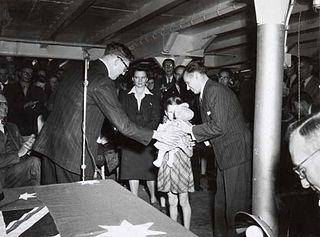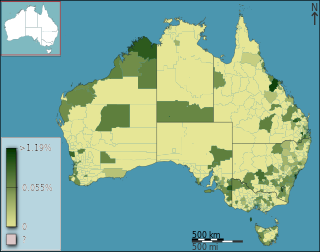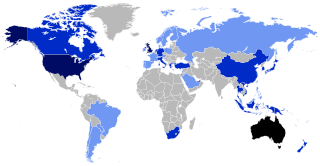
The White Australia policy was a set of racist policies that aimed to forbid people of non-European ethnic origins – especially Asians and Pacific Islanders – from immigrating to Australia in order to create a "white/British" ideal focused on but not exclusively Anglo-Celtic peoples. Pre-Federation, the Australian colonies passed many anti-Chinese immigration laws mainly using Poll Taxes, with Federation in 1901 came discrimination based on the Dictation Test, which effectively gave power to immigration officials to racially discriminate without mentioning race. The policy also affected immigrants from Germany, Italy, and other European countries, especially in wartime. Governments progressively dismantled such policies between 1949 and 1973. At first these changes were due to international pressure and were token modifications designed to maintain a white Australia until the Whitlam government removed the last racial elements of Australia's immigration laws.

Post-war immigration to Australia deals with migration to Australia in the decades immediately following World War II, and in particular refers to the predominantly European wave of immigration which occurred between 1945 and the end of the White Australia policy in 1973. In the immediate aftermath of World War II, Ben Chifley, Prime Minister of Australia (1945–1949), established the federal Department of Immigration to administer a large-scale immigration program. Chifley commissioned a report on the subject which found that Australia was in urgent need of a larger population for the purposes of defence and development and it recommended a 1% annual increase in population through increased immigration.

Serbian Australians, are Australians of ethnic Serb ancestry. In the 2021 census there were 94,997 people in Australia who identified as having Serb ancestry, making it a significant group with the global Serb diaspora.

Korean Australians are Australian citizens who trace their Korean ancestry and identify themselves as an immigrant to or a descendant born in Australia.

Australians, colloquially known as Aussies, are the citizens, nationals and individuals associated with the country of Australia. This connection may be residential, legal, historical or ethno-cultural. For most Australians, several of these connections exist and are collectively the source of their being Australian. Australian law does not provide for a racial or ethnic component of nationality, instead relying on citizenship as a legal status.

Maltese Australians are Australian citizens who are fully or partially of Maltese descent or Malta-born persons who reside in Australia. While most of them emigrated to Australia from Malta, a number emigrated from the United Kingdom where they had settled after having been expelled from Egypt, as holders of British passports, during the Suez Crisis. According to the 2021 Census, there were 198,989 people of Maltese descent in Australia and 35,413 Malta-born people residing in the country at the moment of the census.
Swedish Australians are Australians with Swedish ancestry, most often related to the large groups of immigrants from Sweden in the late nineteenth century and early twentieth century. The 2011 Census showed 34,029 people who claimed Swedish ancestry, having an increase compared to those 30,375 in 2006. Most Swedish Australians are Lutherans affiliated with the Evangelical Lutheran Church. They form the largest Scandinavian minority in Australia.
Slovene Australians are Australian citizens who are fully or partially of Slovene descent or Slovenia-born people who reside in Australia.

English Australians, also known as Anglo-Australians, are Australians whose ancestry originates wholly or partly in England. In the 2021 census, 8,385,928 people, or 33% of the Australian population, stated that they had English ancestry. It is the largest self-identified ancestry in Australia. People of ethnic English origin have been the largest group to migrate to Australia since the establishment of the Colony of New South Wales in 1788.
Hispanic and Latin American Australians refers to Australians who are of Hispanic, and/or Latin American origin irrespective of their ancestral backgrounds, and their descendants. Brazilian Australians make up the largest proportion of Latin American Australians, while Chilean Australians make up the largest group of Hispanic Australians, followed by Salvadoran Australians. Most Hispanic and Latin American Australians speak English but many continue to use Spanish or Portuguese as well.

Spanish Australians refers to Australian citizens and residents of Spanish descent, or people who were born in Spain and immigrated to Australia. There are approximately 123,000 Australians who are of full or partial Spanish descent, most of whom reside within the major cities of Sydney and Melbourne, with lesser but rapidly growing numbers in Brisbane and Perth. Of these, according to the 2011 Australian census, 13,057 were born in Spain.
Argentine Australians are Australian citizens of Argentine descent or birth. According to the Census there were 9,879 Australians who claimed full or partial Argentine ancestry and 20,940 Argentina-born citizens who were residing in Australia at the moment of the census.
Salvadoran Australians are Australians of Salvadoran descent. Salvadoran immigration to Australia was caused principally by economic and political turmoil in El Salvador.
New Zealanders of African descent represent less than 0.3% of New Zealand's population, although the number has been growing substantially since the 1990s.

Singaporean Australians are Australians of Singaporean descent. As Singapore is a multi-racial country, a Singaporean Australian could either be of Chinese, Malay or Indian descent, the main races of Singapore. According to the 2006 Australian census, 39,969 Australians were born in Singapore while 4,626 claimed Singaporean ancestry, either alone or with another ancestry.
Hong Kong Australians are Australian citizens or permanent residents of Hong Kong descent. Many Hong Kong Australians hold dual citizenship of Australia and Hong Kong.

Canadian Australians refers to Australians who identify as being of Canadian descent. It may also refer to Canadian immigrants and expatriates residing in Australia. According to statistics from 2006, there were as many as 21,000 Australians who have Canadian ancestors. Many Canadian Australians have immigrated from mainland Canada, as well as from the United States of America and from the United Kingdom. According to the 2016 Australian Census, there were 43,049 Canadian born Australians in Australia in 2016, which is an increase from 38,871 persons according to the 2011 Australian Census. The number of immigrants stem from both countries being former British colonies and both being parliamentary democracies in the Westminster tradition.
Latvian Australians are Australian citizens of Latvian descent, or persons born in Latvia who reside in Australia. At the 2016 Census, 20,509 residents in Australia reported to have Latvian ancestry.
Lithuanian Australians refers to Australian residents of Lithuanian national background or descent. According to the 2021 Census, there were 19,430 people of Lithuanian descent in Australia and 2,582 Lithuania-born people residing in the country at the moment of the census. As of 2016, the largest Lithuanian Australian community resides in the state of New South Wales, with 1022 Lithuania-born people, especially located in Sydney.

Foreign relations exist between Australia and Lithuania. Australia was among the first countries to re-recognise Lithuania's independence on 27 August 1991. Both countries formally established diplomatic relations on 6 November 1991. Australia is represented in Lithuania through its embassy in Warsaw, Poland and an honorary consulate in Vilnius. Lithuania has had an embassy in Canberra since 2021, and also has honorary consulates in Sydney, Adelaide, Melbourne and Darwin.











